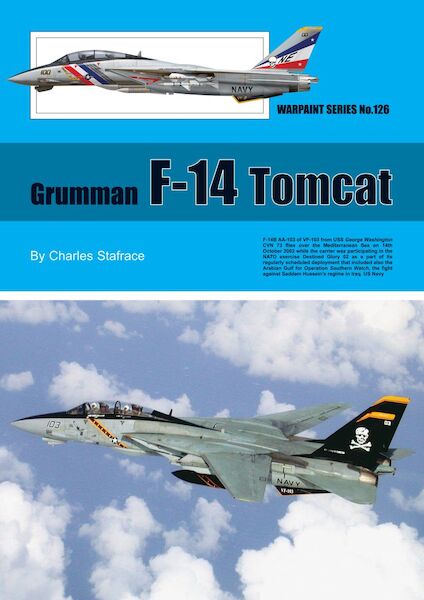
- aviationmegastore.com
- aviationoutletstore.com
- Ship to United States
Quick Search – Outlet Store
Aviation Outlet Store
categoriesGrumman F14 Tomcat
Product code ws-126
Grumman
€ 27.48
Series Warpaint Series No 126
Publisher/Brand Hall Park
Author Charles Stafrace
Format a4
No. Pages 124
Version Soft cover
Language English
Category Aviationbooks
Subcategory US » US Jet Aircraft
Availability only 3 remaining
This product was added to our database on Thursday 3 September 2020.
Your reliable Aviation Book Source since 1989
Also in this series:
| product | Publisher/Brand | Series/scale | Price € | ||
 | Airspeed Oxford and Consul | Hall Park | Warpaint Series No 136 | € 20.14 | |
 | Cessna T37A/B/C 'Tweet' and the A37A/B 'Dragonfly' | Hall Park | Warpaint Series No 127 | € 22.89 | |
 | de Havilland (Canada) DHC-2 Beaver | Hall Park | Warpaint Series No 139 | € 20.14 | |
 | English Electric Lightning | Hall Park | Warpaint Series No 14 | € 20.14 | |
 | Grumman F6F Hellcat | Hall Park | Warpaint Series No 84 | € 18.30 | |
 | Handley Page Victor | Hall Park | Warpaint Series No 36 | € 15.55 | |
 | Hawker Sea Harrier | Hall Park | Warpaint Series No 75 | € 14.63 | |
 | Ilyushin IL2 Sturmovik | Hall Park | Warpaint Series No 107 | € 15.55 | |
 | Mirage F1 | Hall Park | Warpaint Series No 142 | € 20.14 | |
 | Saab Draken | Hall Park | Warpaint Series No 80 | € 17.39 |
Product description
The US Navy embarked on the VFX fighter programme when it became obvious that the weight, engine and manoeuvrability issues plaguing F-111B, the naval variant of the Tactical Fighter Experimental (TFX), would not be resolved to the Navy's satisfaction. The Navy requirement was for a fleet air defence fighter whose primary role was intercepting Soviet bombers before they could launch missiles against the carrier battle group. The Navy strenuously opposed the TFX, which incorporated the US Air Force's requirements for a low-level attack aircraft that were not required by the Navy. Grumman came up with a solution in the form of their F-14 Tomcat, a supersonic, twin-engine, two-seat, variable-sweep wing aircraft. But what made the Tomcat head and shoulders above all other fighters was its AWG-9 weapons control radar married to the superlative AIM-54A Phoenix air-to-air missile. The Tomcat was all the US Navy required, and the F-111B episode was soon forgotten. The F-14A was the first version of the Tomcat, and it entered US Navy service in 1972 with VF-1 and VF-2 and first deployed overseas on USS Enterprise in 1974, gradually replacing the later versions of the F-4 Phantom on the US carriers' decks. The F-14A served only with one foreign air force, the Imperial Iranian Air Force which, after the 1978 revolution, came to be known as the Iranian Islamic Iranian Air Force. The Tomcat's role in Iran's war against Iraq from 1980 to 1988 is explained in detail. The Iranian, in its locally-improvised versions, is still in service. The F-14A version of the Tomcat inherited not only the AWG-9/AIM-54 system from the ill-fated F-111B but also its troublesome TF30 engine. In the US Navy it was only when the F-14B was re-engined with the more powerful and more reliable F-110-GE-400, as was also the F-14D, that the Tomcat really showed its true potential in the air. The Tomcat went on to serve on all US carriers of the Forrestal and Kitty Hawk Class of carriers and on all nuclear powered carriers built until 2006, the year when the Tomcat was retired from service. During the years it spent on deck, the Tomcat, in its F-14A, F-14B and F-14D versions, participated in all US interventions of the 1980s, 1990s and 2000s in the Mediterranean, Middle East and Horn of Africa, and distinguished itself not only as an interceptor fighter, but later also as a ground support and reconnaissance aircraft when the need for these two new roles were needed and when equipped with the LANTIRN and TARPS systems. The Tomcat's story was immortalised by the Hollywood production that made 'Tomcat' and 'Top Gun' household names, but in real life the Tomcat was truly a confirmed 'MiG-killer' and a 'Sukhoi-killer' in encounters with hostile Libyan opposition. Its exit from the US Navy scene in 2006 was a controversial one, as the aircraft was still considered a valuable asset to the fleet. However, its astronomical maintenance hours per flight hours and its ageing systems compared with the newer F/A-18 Hornet worked against it. All this is explained in detail in this new Warpaint title, a 124-page account of America's most famous fighter of recent times, that contains no fewer than 280 photos, ten pages of colour profiles, scale plans, fourteen information tables and a text that give exact details of every squadrons, details of all deployments with carrier, CVW, dates and destination, conversions to later versions, and many other information as now expected from titles by author Charles Stafrace, supported by superb artwork by John Fox
Shopping cart
Your shopping cart is empty.
Login
Already a customer on our main website AviationMegastore.com? Your login is also valid in the outlet store.
- aviationshopsupplies.com
- aviationmegatrade.com
© 1989–2025 Luchtvaart Hobby Shop B.V.